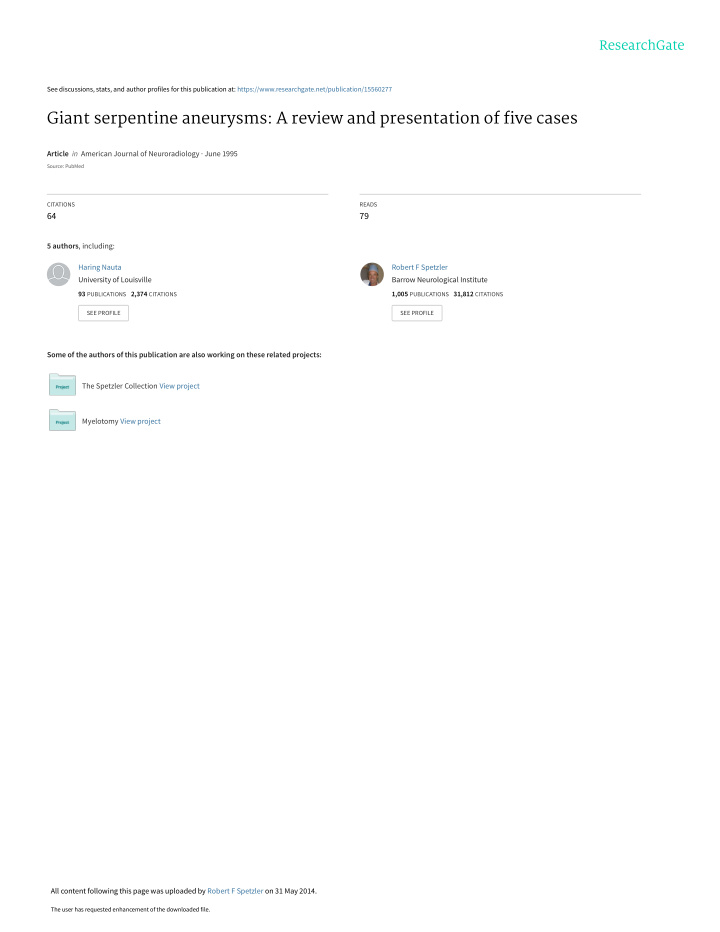



See discussions, stats, and author profiles for this publication at: https://www.researchgate.net/publication/15560277 Giant serpentine aneurysms: A review and presentation of five cases Article in American Journal of Neuroradiology · June 1995 Source: PubMed CITATIONS READS 64 79 5 authors , including: Haring Nauta Robert F Spetzler University of Louisville Barrow Neurological Institute 93 PUBLICATIONS 2,374 CITATIONS 1,005 PUBLICATIONS 31,812 CITATIONS SEE PROFILE SEE PROFILE Some of the authors of this publication are also working on these related projects: The Spetzler Collection View project Myelotomy View project All content following this page was uploaded by Robert F Spetzler on 31 May 2014. The user has requested enhancement of the downloaded file.
Giant Serpentine Aneurysms: A Review and Presentation of Five Cases Victor A. Aletich, Gerard M. Debrun, Lee H. Monsein, Haring J. W. Nauta, and Robert F. Spetzler Summary: We present five cases of giant serpentine aneurysms bral artery with slow flow along its medial and superior (large, partially thrombosed aneurysms containing tortuous vas- aspect and lamellated thrombus throughout the remaining cular channels with a separate entrance and outflow pathway) portion. An angiogram performed the next day demon- and review 28 cases reported in the literature. Giant serpentine strated a giant serpentine aneurysm at the right middle aneurysms should be considered as a subgroup of giant aneu- cerebral artery trifurcation. The aneurysm had a well- rysms, distinct from saccular and fusiform varieties, given their defined neck associated with a surrounding large avascu- unique clinical presentation and radiographic features. lar component displacing the right middle cerebral artery. The main branches of the middle cerebral artery, including Index terms: Aneurysm, giant; Interventional neuroradiology the angular branch, originated proximal to the aneurysm neck. A small middle cerebral artery branch, however, In 1977 Segal and McLaurin introduced the arose from a separate outflow pathway. The patient re- term giant serpentine aneurysm as a subcate- quested a second opinion before therapy and was dis- gory of giant aneurysms, distinct from the sac- charged pending further consultation. cular variety, based on observations of two The patient was admitted to Johns Hopkins Hospital in November 1989 for reevaluation. She had been neurolog- cases and literature review. Subsequently, sev- ically intact and seizure free during the time interval. A CT eral case reports and reviews have further de- scan again demonstrated the large central and peripher- fined the clinical presentation and pathophysi- ally calcified mass in the right frontotemporal region. After ology of these aneurysms. This article presents contrast administration, however, no enhancement could five cases and reviews the literature in an at- be identified within the center of the lesion. Peripheral tempt to clarify further the presentation, diag- enhancement not previously noted was identified. On MR nosis, and treatment of giant serpentine aneu- the lesion had a heterogeneous signal compatible with rysms. thrombus of variable age (Fig 1A). No central flow could be identified on gradient-echo images (Fig 1B). A repeat cerebral angiogram and a subsequent angiogram 3 Case Reports months later demonstrated vascular displacement com- patible with the known mass in the frontotemporal region Case 1 and complete thrombosis of the aneurysm. MR performed A 44-year-old, right-handed woman with history of sei- 1 year later demonstrated a persistent thrombosed aneu- zures, well-controlled hypertension, and obesity was ad- rysm with chronic changes. The patient remains clinically mitted to an outside institution in June 1989 after a grand stable without focal neurologic abnormalities. mal seizure. Neurologic examination revealed intact cra- nial nerves and motor systems. Sensory modalities were preserved, and laboratory examinations were unremark- Case 2 able. A computed tomographic (CT) scan showed a large right frontotemporal mass approximately 4.5 � 4.0 � 3.7 A 34-year-old woman presented with left-sided weak- cm of increased heterogeneous attenuation with peripheral ness, finger agnosia, tinnitus, and right homonymous ring and central calcification. After contrast administra- hemianopsia in July 1990. CT evaluation showed a lobu- tion, eccentric and central regions of enhancement were lated mass 6.0 � 4.5 � 4.0 cm of heterogeneous increased visible. There was no evidence of hemorrhage. Magnetic density, partially calcified in its periphery, that involved the resonance (MR) imaging showed a partially thrombosed right frontotemporal region with moderate mass effect (Fig aneurysm arising from the region of the right middle cere- 2A). After contrast administration, an eccentric, serpigi- Received December 22, 1992; accepted after revision August 19, 1993. From the Department of Radiology, Division of Neuroradiology, Radiology, and Radiological Sciences (V.A.A., G.M.D., L.H.M.), and Department of Neurosurgery (H.J.W.N.), Johns Hopkins University, Baltimore, Md; and Section of Neurosurgery, Barrow Neurological Institute, University of Arizona, Phoenix (R.F.S.). Address reprint requests to Gerard M. Debrun, MD, Department of Neurosurgery, University of Illinois at Chicago, 912 S Wood St, Chicago, IL 60612. AJNR 16:1061–1072, May 1995 0195-6108/95/1605–1061 � American Society of Neuroradiology 1061
Recommend
More recommend